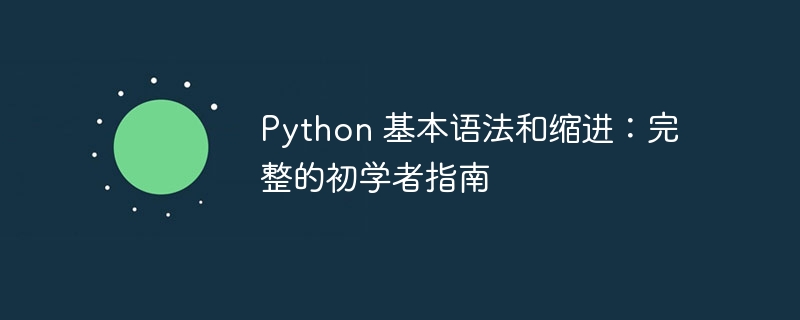◎欢迎参与讨论,请在这里发表您的看法、交流您的观点。
Python 基本语法和缩进:完整的初学者指南
ID:21935 / 打印
当你第一次学习编程时,python 因一个特殊原因而脱颖而出:它的设计目的几乎像英语一样阅读。与使用大量符号和括号的其他编程语言不同,python 依赖于简单、干净的格式,使您的代码看起来像组织良好的文档。
将 python 的语法视为语言的语法规则。正如英语有关于如何构造句子以使含义清晰的规则一样,python 也有关于如何编写代码以便人类和计算机都能理解的规则。
理解python的基本语法
构建模块
让我们从最简单的 python 语法元素开始:
# this is a comment - python ignores anything after the '#' symbol student_name = "alice" # a variable holding text (string) student_age = 15 # a variable holding a number (integer) # using variables in a sentence (string formatting) print(f"hello, my name is {student_name} and i'm {student_age} years old.") 在此示例中,我们使用了 python 的几个基本元素:
- 评论(以#开头的行)
- 变量(student_name 和 student_age)
- 字符串格式(f"..." 语法)
- 打印功能
基本操作
python可以像计算器一样进行计算和比较:
# basic math operations total_score = 95 + 87 # addition average = total_score / 2 # division # comparisons if student_age >= 15: print(f"{student_name} can take advanced classes") python 的核心:理解缩进
这就是 python 真正独特的地方:python 使用缩进,而不是使用括号或特殊符号将代码组合在一起。乍一看这可能看起来很奇怪,但它使 python 代码异常清晰易读。
立即学习“Python免费学习笔记(深入)”;
缩进如何创建结构
将缩进想象为组织详细大纲的方式:
def make_sandwich(): print("1. get two slices of bread") # first level if has_cheese: print("2. add cheese") # second level print("3. add tomatoes") # still second level else: print("2. add butter") # second level in else block print("4. put the slices together") # back to first level 每个缩进块都告诉 python“这些行属于一起”。这就像在大纲中创建一个子列表 - “if has_cheese:”下缩进的所有内容都是该条件的一部分。
缩进规则
让我们看看python缩进的关键规则:
def process_grade(score): # rule 1: use exactly 4 spaces for each indentation level if score >= 90: print("excellent!") if score == 100: print("perfect score!") # rule 2: aligned blocks work together elif score >= 80: print("good job!") print("keep it up!") # this line is part of the elif block # rule 3: unindented lines end the block print("processing complete") # this runs regardless of score 嵌套缩进:更深入
随着您的程序变得更加复杂,您通常需要多级缩进:
def check_weather(temperature, is_raining): # first level: inside function if temperature > 70: # second level: inside if if is_raining: # third level: nested condition print("it's warm but raining") print("take an umbrella") else: print("it's a warm, sunny day") print("perfect for outdoors") else: print("it's cool outside") print("take a jacket") 复杂的结构和压痕
让我们看一个更复杂的示例,它展示了缩进如何帮助组织代码:
def process_student_grades(students): for student in students: # first level loop print(f"checking {student['name']}'s grades...") total = 0 for grade in student['grades']: # second level loop if grade > 90: # third level condition print("outstanding!") total += grade average = total / len(student['grades']) # back to first loop level if average >= 90: print("honor roll") if student['attendance'] > 95: # another level print("perfect attendance award") 常见模式和最佳实践
处理多种条件
# good: clear and easy to follow def check_eligibility(age, grade, attendance): if age < 18: return "too young" if grade < 70: return "grades too low" if attendance < 80: return "attendance too low" return "eligible" # avoid: too many nested levels def check_eligibility_nested(age, grade, attendance): if age >= 18: if grade >= 70: if attendance >= 80: return "eligible" else: return "attendance too low" else: return "grades too low" else: return "too young"
使用函数和类
class student: def __init__(self, name): self.name = name self.grades = [] def add_grade(self, grade): # notice the consistent indentation in methods if isinstance(grade, (int, float)): if 0 <= grade <= 100: self.grades.append(grade) print(f"grade {grade} added") else: print("grade must be between 0 and 100") else: print("grade must be a number") 常见错误及其解决方法
缩进错误
# wrong - inconsistent indentation if score > 90: print("great job!") # error: no indentation print("keep it up!") # error: inconsistent indentation # right - proper indentation if score > 90: print("great job!") print("keep it up!") 混合制表符和空格
# wrong - mixed tabs and spaces (don't do this!) def calculate_average(numbers): total = 0 count = 0 # this line uses a tab for num in numbers: # this line uses spaces total += num
练习:将它们放在一起
尝试编写这个程序来练习缩进和语法:
def grade_assignment(score, late_days): # Start with the base score final_score = score # Check if the assignment is late if late_days > 0: if late_days <= 5: # Deduct 2 points per late day final_score -= (late_days * 2) else: # Maximum lateness penalty final_score -= 10 # Ensure score doesn't go below 0 if final_score < 0: final_score = 0 # Determine letter grade if final_score >= 90: return "A", final_score elif final_score >= 80: return "B", final_score elif final_score >= 70: return "C", final_score else: return "F", final_score # Test the function score = 95 late_days = 2 letter_grade, final_score = grade_assignment(score, late_days) print(f"Original Score: {score}") print(f"Late Days: {late_days}") print(f"Final Score: {final_score}") print(f"Letter Grade: {letter_grade}") 要点
- python 使用缩进来理解代码结构
- 每一级缩进始终使用 4 个空格
- 在整个代码中保持缩进一致
- 更简单、更扁平的代码结构通常比深度嵌套的代码更好
- 适当的缩进使代码更具可读性并有助于防止错误
下一步
现在您已经了解了 python 的基本语法和缩进:
- 练习编写简单的程序,重点关注正确的缩进
- 了解不同的数据类型(字符串、数字、列表)
- 探索函数和类
- 研究循环和控制结构
- 开始使用 python 模块和库
记住:良好的缩进习惯是成为熟练python程序员的基础。花点时间掌握这些概念,剩下的就会水到渠成!
